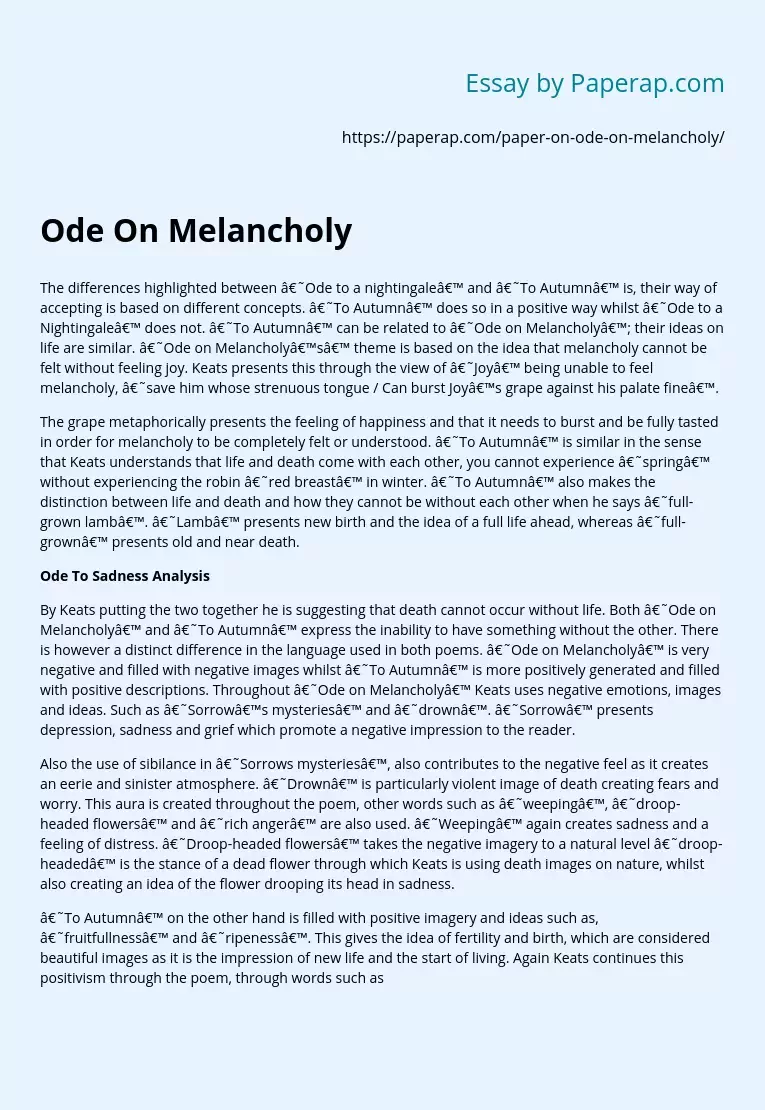Ode On Melancholy
The differences highlighted between ‘Ode to a nightingale’ and ‘To Autumn’ is, their way of accepting is based on different concepts. ‘To Autumn’ does so in a positive way whilst ‘Ode to a Nightingale’ does not. ‘To Autumn’ can be related to ‘Ode on Melancholy’; their ideas on life are similar. ‘Ode on Melancholy’s’ theme is based on the idea that melancholy cannot be felt without feeling joy. Keats presents this through the view of ‘Joy’ being unable to feel melancholy, ‘save him whose strenuous tongue / Can burst Joy’s grape against his palate fine’.
The grape metaphorically presents the feeling of happiness and that it needs to burst and be fully tasted in order for melancholy to be completely felt or understood. ‘To Autumn’ is similar in the sense that Keats understands that life and death come with each other, you cannot experience ‘spring’ without experiencing the robin ‘red breast’ in winter. ‘To Autumn’ also makes the distinction between life and death and how they cannot be without each other when he says ‘full-grown lamb’.
‘Lamb’ presents new birth and the idea of a full life ahead, whereas ‘full-grown’ presents old and near death.
Ode To Sadness Analysis
By Keats putting the two together he is suggesting that death cannot occur without life. Both ‘Ode on Melancholy’ and ‘To Autumn’ express the inability to have something without the other. There is however a distinct difference in the language used in both poems. ‘Ode on Melancholy’ is very negative and filled with negative images whilst ‘To Autumn’ is more positively generated and filled with positive descriptions.
Throughout ‘Ode on Melancholy’ Keats uses negative emotions, images and ideas. Such as ‘Sorrow’s mysteries’ and ‘drown’. ‘Sorrow’ presents depression, sadness and grief which promote a negative impression to the reader.
Also the use of sibilance in ‘Sorrows mysteries’, also contributes to the negative feel as it creates an eerie and sinister atmosphere. ‘Drown’ is particularly violent image of death creating fears and worry. This aura is created throughout the poem, other words such as ‘weeping’, ‘droop-headed flowers’ and ‘rich anger’ are also used. ‘Weeping’ again creates sadness and a feeling of distress. ‘Droop-headed flowers’ takes the negative imagery to a natural level ‘droop-headed’ is the stance of a dead flower through which Keats is using death images on nature, whilst also creating an idea of the flower drooping its head in sadness.
‘To Autumn’ on the other hand is filled with positive imagery and ideas such as, ‘fruitfullness’ and ‘ripeness’. This gives the idea of fertility and birth, which are considered beautiful images as it is the impression of new life and the start of living. Again Keats continues this positivism through the poem, through words such as ‘sound asleep’, ‘patient look’ and ‘drowsed’, these also creates positive images. Being ‘sound’ asleep creates connotations of being relaxed and in a place of calm and serenity.
‘Patient’ look creates the same type of aura, that life is calm and simple; full of neither patience not worry nor distress. It is clear that ‘Ode on Melancholy’ is very negative and ‘To Autumn’ is particularly positive in its presentation what also makes them similar is that Keats has created an image and run it through the entire poem without change but a continuous feel of the same emotion be it negative or positive.
The way in which ‘To Autumn’ stands out from the other odes is its outlook on life and death, and its ability to fully accept both from the offset. The other odes however have a begrudging ability to accept anything. ‘To autumn’ is the only of the poems which does not have ten lines in its stanza’s, it is as if the eleventh line is that extra bit of understanding and positivism, the extra space to be able to accept death.
‘To Autumn’ is a far more inspirational and beautifully positive poem creating a placid, relaxed and loving view whilst the others tend to make us, the reader, feel down and miserable as they have a much more pessimistic view on life. Show preview only The above preview is unformatted text This student written piece of work is one of many that can be found in our GCSE John Keats section.
Ode On Melancholy. (2019, Dec 05). Retrieved from https://paperap.com/paper-on-ode-on-melancholy/

